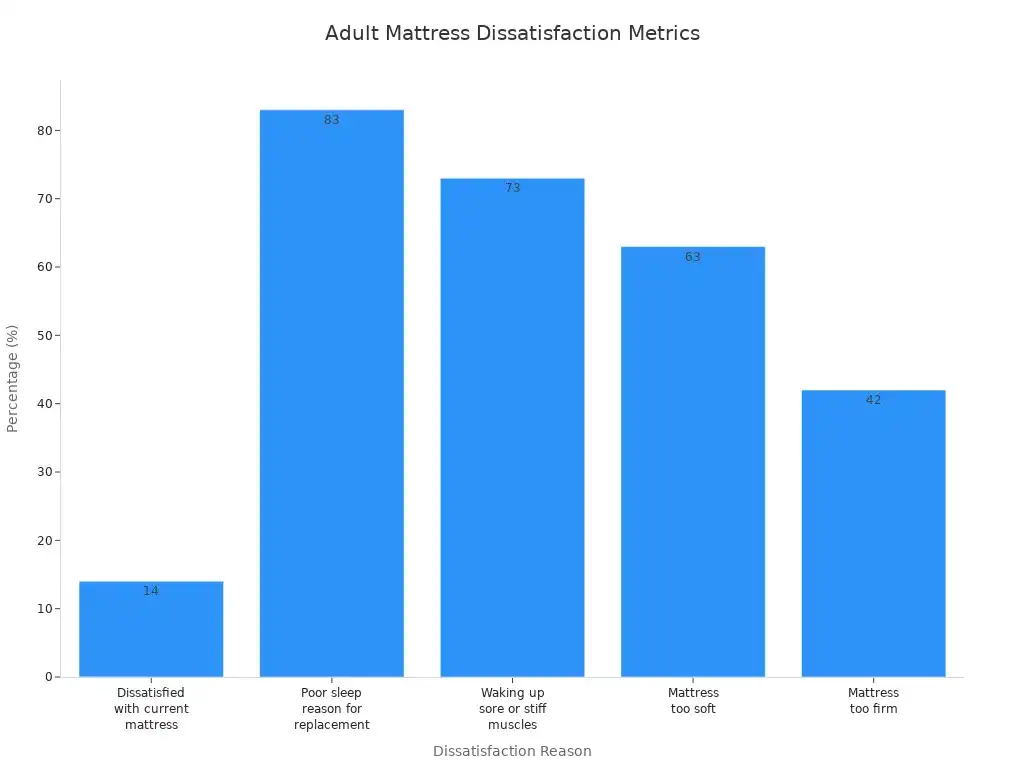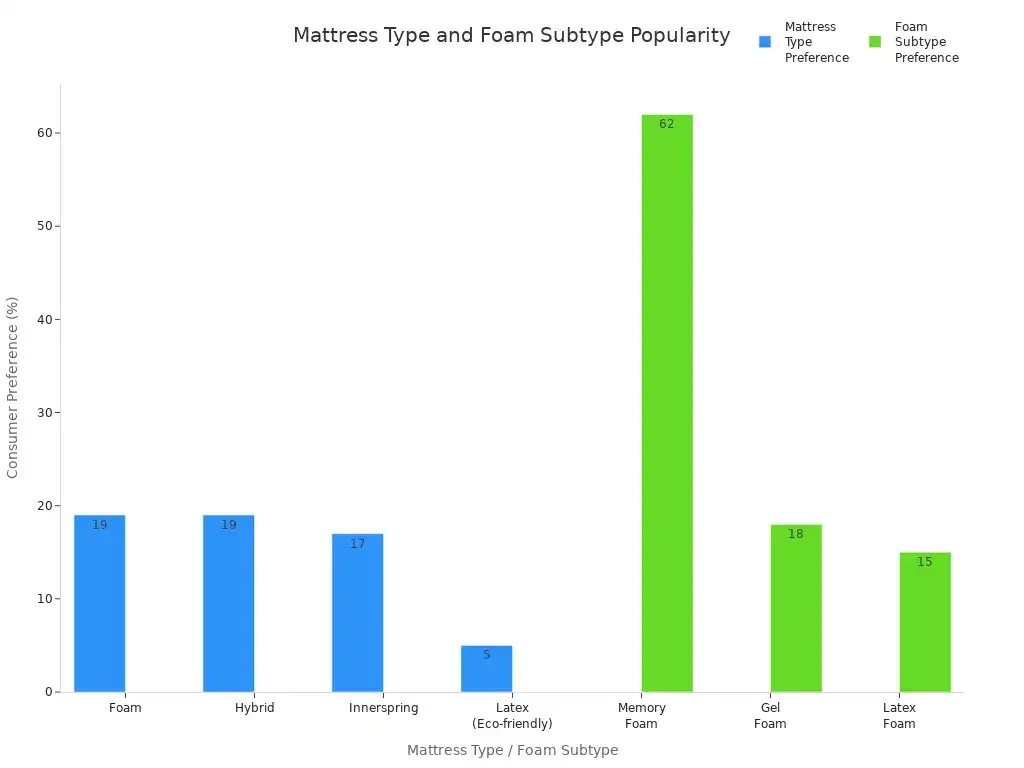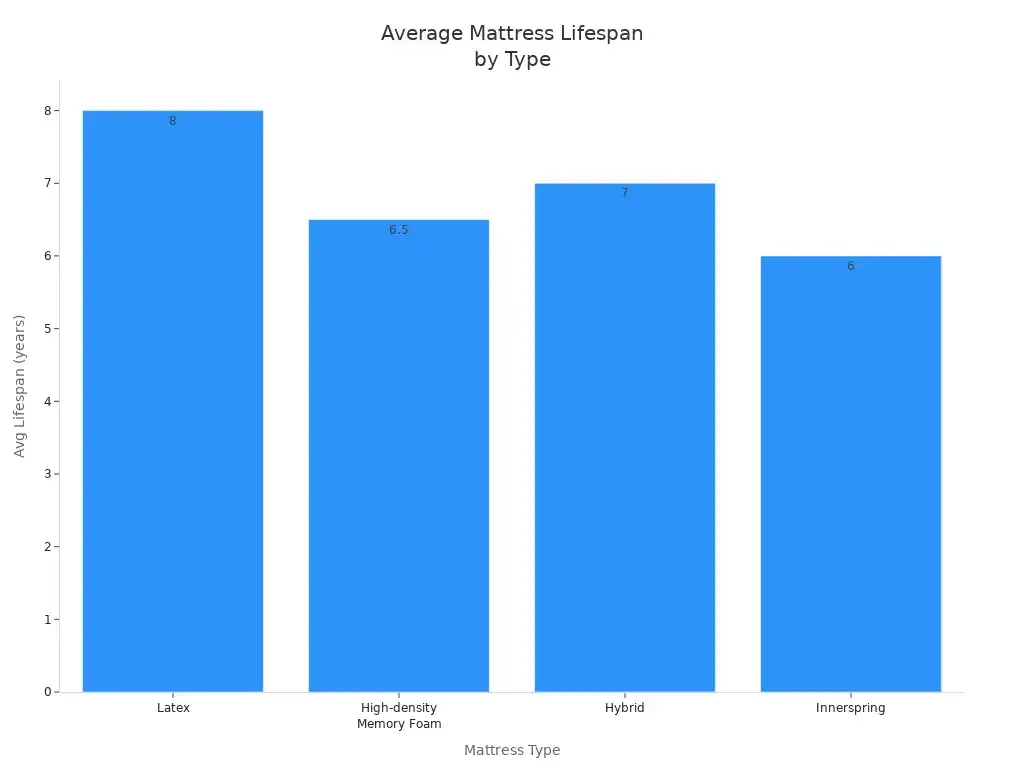Address
No.3 Chengcai Road, Leliu Town, Shunde District, Foshan City, Guangdong, China 528322
Address
No.3 Chengcai Road, Leliu Town, Shunde District, Foshan City, Guangdong, China 528322
Choose a mattress manufacturer with quality materials, clear policies, and strong support to match your comfort needs and budget.


You should have a mattress that fits you well. Many people wake up sore or stiff. Here is how often these problems happen:
Complaint Type | Percentage of Respondents |
|---|---|
Mattress too soft | 35% |
Mattress not supportive | 8.32% |
Mattress too firm | 18% |

You need a mattress manufacturer that cares about comfort. They should use good materials and have fair rules. If you see clear facts about materials and service, you can trust them. A good mattress helps your health. It helps you wake up feeling good.
Pick a mattress that matches how you sleep and your body weight. This helps you feel comfortable and supported.
Think about different mattress types like foam, innerspring, hybrid, and latex. Choose the one that fits your needs and your budget.
Find a mattress firmness that works with your sleep style. This keeps your spine straight and helps stop pain.
Decide how much money you want to spend. Focus on getting good value by looking at the materials, how long it lasts, and extra features before you buy.
Buy straight from the manufacturer to save money. You can also get better return rules and warranties this way.
Check if the mattress brand is trusted and honest. Look for certifications to make sure it is safe and good quality.
Try out mattresses in a store or use online trial times. This helps you find the best one without any risk.
Pick brands that have good customer service. Make sure their return and warranty rules are clear so you feel safe.
You probably have a favorite way to sleep. Maybe you curl up on your side, stretch out on your back, or even sleep on your stomach. Each position needs a different kind of mattress to keep you comfortable and supported.
Most adults sleep on their side. This position helps with joint pain and can even reduce snoring. If you sleep on your side, you want a medium-soft mattress. It cushions your shoulders and hips, so you do not wake up sore.
Back sleepers need a mattress that keeps their spine straight. A medium-firm mattress works best. It gives support but still feels comfortable. Sleeping on your back can help with breathing and reduce pressure on your ribs.
Stomach sleeping is not as common. If you sleep this way, you need a firm mattress. Soft beds let your hips sink too much, which can hurt your back and neck. A firm mattress keeps your body flat and helps you avoid pain.
Do you move around a lot at night? Combo sleepers change positions often. You need a medium-firm mattress. It gives you support no matter how you sleep.
Here’s a quick look at sleep positions and what works best:
Sleep Position | Benefits | Drawbacks | Best Mattress Type |
|---|---|---|---|
Side (~54% of adults) | Less joint pain, less snoring, better digestion | Shoulder or neck pain if not supported | Medium-soft |
Back | Good for spine, helps breathing | Not great for snorers or sleep apnea | Medium-firm |
Stomach | Can help with snoring | Neck and back pain, pressure on organs | Firm |
Combo | Flexible | None | Medium-firm |
Tip: Your sleep position can change over time. Try different mattresses to see what feels best for you.
Your body type also matters when picking a mattress. If you are lighter (under 130 pounds), you might like a softer mattress. It lets you sink in a little and feels cozy. If you weigh more (over 230 pounds), you need a firmer mattress with thicker layers. This keeps you from sinking too much and helps your spine stay straight. People in the middle (130-230 pounds) usually do well with a medium or medium-firm mattress.
Body Weight | Mattress Type & Firmness | Why It Works |
|---|---|---|
Under 130 lbs | Soft to medium-soft | More sink for pressure relief |
130-230 lbs | Medium to medium-firm | Balance of support and comfort |
Above 230 lbs | Medium-firm to firm, thicker | Prevents sinking, supports spine |
Mattress materials matter, too. Memory foam hugs your body, but if you are heavier, it can feel too soft. Latex gives good support for all weights. Coils and springs add extra support and last longer.
If you wake up with a sore back, you are not alone. Many people need a mattress that keeps their spine in a healthy line. Medium-firm mattresses often help most. Memory foam can also help because it shapes to your body. Make sure your mattress is not too old—replacing it every 9-10 years can make a big difference. Try your mattress for at least a month to see if your pain gets better.
Do you get hot at night? Look for mattresses with cooling features. Latex and some hybrid mattresses breathe better than regular foam. Some mattresses have special covers or gels to keep you cool.
If you have allergies, you want a mattress that keeps dust and bugs away. Latex and some foams resist dust mites and mold. Washable covers help, too. Always check if the mattress is hypoallergenic.
😊 Remember: Your sleep needs are unique. The right mattress makes a big difference in how you feel every morning.

Foam mattresses are everywhere these days. You might know memory foam from TV ads or friends who rave about their beds. Foam mattresses, especially memory foam, mold to your body. They give you pressure relief and help keep your spine straight. If you sleep on your side or have sore spots, foam can feel like a hug for your joints.
Memory foam also does a great job at stopping motion transfer. If you share your bed, you won’t feel every toss and turn from your partner. That’s a big win for light sleepers. Gel foam is another option. It feels cooler than regular memory foam, which helps if you get hot at night.
Here’s a quick look at foam mattress preferences:
Foam Mattress Type | Preference (%) | What People Like |
|---|---|---|
Memory Foam | Comfort, support | |
Gel Foam | 18 | Cooler feel |
Latex Foam | 15 | Eco-friendly |
Foam mattresses are the most popular choice right now. They work well for many people, especially if you want comfort and pressure relief.
Innerspring mattresses use steel coils for support. You might remember these from your childhood or guest rooms. They feel bouncy and give you a classic mattress feel. Innerspring beds are great if you like a firmer, more responsive surface.
These mattresses offer good airflow, so you stay cooler at night. They also tend to cost less than some other types. However, they don’t contour to your body as much as foam. If you need extra pressure relief or have joint pain, innerspring might not be your best bet.
Even though innerspring mattresses are still common, fewer people choose them now. Many shoppers want more comfort and motion isolation.
Hybrid mattresses mix the best parts of foam (or latex) and innerspring. You get the comfort and pressure relief from foam or latex, plus the support and bounce from coils. Hybrids often have better edge support, so you can use the whole bed without feeling like you’ll roll off.
These beds work well for almost everyone. If you want a mattress that feels balanced—not too soft, not too firm—a hybrid could be perfect. They also help with temperature control, which is great if you sleep hot.
Hybrids are quickly gaining fans. People love the mix of comfort and support. Check out this chart to see how foam and hybrid mattresses lead in popularity:

Tip: If you can’t decide between foam and innerspring, try a hybrid. You might get the best of both worlds.
Latex mattresses stand out for their natural feel and eco-friendly materials. If you want a mattress that feels bouncy and supportive, latex could be your best pick. You get a bed that responds quickly when you move. This makes it easy to change positions at night.
Latex comes from rubber tree sap. Some mattresses use natural latex, while others use synthetic or blended latex. Natural latex is more durable and better for the environment. Synthetic latex costs less but may not last as long.
You might like latex if you want a mattress that stays cool. Latex has an open-cell structure, so air moves through it easily. This helps you sleep cooler than on most foam beds. If you have allergies, latex can help too. It resists dust mites and mold, making it a good choice for sensitive sleepers.
Here are some reasons people choose latex mattresses:
Long-lasting: Latex beds can last over 10 years with proper care.
Supportive: They keep your spine in line and reduce pressure on your joints.
Eco-friendly: Natural latex is a renewable resource.
Hypoallergenic: Great for people with allergies.
Note: Latex mattresses often feel firmer than memory foam. If you want a softer feel, look for a latex bed with a plush top layer.
Latex works well for many sleep positions. Side sleepers get pressure relief, while back and stomach sleepers enjoy steady support. If you want a mattress that combines comfort, bounce, and durability, latex is worth a try.
When you shop for a mattress, you’ll see firmness described on a scale from 1 to 10. A 1 feels extra soft, while a 10 feels extra firm. Most people find comfort in the middle, around 5 to 7. This scale helps you compare mattresses from different brands, even though each company may use slightly different terms.
Here’s a quick guide to firmness levels:
Firmness Level | Scale Number | Who It Suits Best |
|---|---|---|
Soft | 3-4 | Side sleepers, lighter people |
Medium | 5-6 | Combo sleepers, most adults |
Medium-Firm | 6.5-7 | Back sleepers, couples |
Firm | 8+ | Stomach sleepers, heavier people |
Firmness is about how the mattress feels when you first lie down. Support is different—it’s about how well the mattress keeps your spine straight. You might notice that foam mattresses feel softer and hug your body, while latex beds feel firmer and more springy. Hybrids mix these features to hit the right balance.
Your body weight and sleep position change how a mattress feels. If you weigh more, you might sink deeper and feel a mattress as softer. If you’re lighter, the same bed may feel firmer. That’s why it’s smart to try out mattresses or check return policies before you buy.
😊 Tip: Use the firmness scale as a starting point, but trust your own comfort. What feels perfect to you might not work for someone else. Always test a mattress if you can!
You want a mattress that feels great but does not break the bank. Start by thinking about how much you can spend. Mattresses come in many price ranges. Some cost a few hundred dollars, while others go over a thousand. Set a budget that fits your needs and your wallet. Remember, a higher price does not always mean better sleep. You can find quality options at many price points.
When you shop, look at what each mattress offers. Some brands add extra features, like cooling covers or longer warranties. These can raise the price. Decide which features matter most to you. Make a list of your must-haves and nice-to-haves. This helps you stay focused and avoid spending more than you planned.
It is easy to think the most expensive mattress is the best. That is not always true. Value means getting the most for your money. Look at the materials, how long the mattress will last, and what kind of support it gives. A mattress that costs a bit more but lasts twice as long can save you money in the long run.
Ask yourself these questions:
Does this mattress use high-quality materials?
Will it support my sleep needs for years?
Are there extra perks, like free delivery or a long trial period?
🛏️ Tip: A good mattress is an investment in your health. Spending a little more now can mean better sleep and fewer aches later.
Buying straight from a mattress manufacturer can save you a lot. When you skip the store, you skip the extra costs. Retailers add markups to cover their own bills and profits. Manufacturers control the whole process, from making the mattress to sending it to your door. This means you get lower prices and faster delivery.
Here is a quick look at how buying direct compares to shopping in a store:
Cost Factor | Factory Direct Benefits | Traditional Retail Costs |
|---|---|---|
Initial Price | Lower direct pricing, no retail markup | Higher due to added retail markup |
Delivery Fees | Often free | Typically $50-$200 |
Return Policy | Free returns | Restocking fees common |
Warranty Coverage | Direct manufacturer support | May require retail mediation |
You can often save 20% to 50% by buying direct. Many manufacturers also offer deals, free shipping, and better return policies. You get more value, more choices, and less hassle. Plus, you can ask for custom features or sizes that stores may not have.
😊 Note: Shopping direct gives you more control and better prices. You get a high-quality mattress without paying extra for the middleman.
When you pick a mattress manufacturer, reputation is very important. A good reputation means you can trust the company. Experts use different ways to check a company’s reputation.
Specification transparency: The best companies tell you what is inside their mattresses. They share things like foam density, coil count, and layer thickness.
Quality control systems: Good brands have strong checks to make sure every mattress is made well. They look for defects and use good materials.
Price and value: A trustworthy company gives fair prices for what you get. You should feel like you are getting your money’s worth.
Transparency is very important. If a company hides what is in their beds, that is a bad sign. You want a brand that is open and honest. Customer reviews help too. When you read reviews, you learn how the company treats people and fixes problems.
📝 Tip: Always look for clear product details and read reviews before you buy. A good reputation means fewer surprises and better sleep.
You want your mattress to last a long time. Durability depends on the materials and how well it is made. Some mattresses last longer than others. Latex and high-density memory foam are strong. Innerspring mattresses usually wear out the fastest.
Here is a table to help you see how long different mattresses last:
Mattress Type | Average Lifespan (years) | Durability Rating | Key Durability Factors |
|---|---|---|---|
Latex | 7.5 – 8.5 | Good to very good | Longest lasting, resists sagging and impressions |
High-density Memory Foam | 6 – 7 | Fair to good | Durable foam, better resistance to sagging |
Hybrid | 6.5 – 7.5 | Fair to good | Mix of foam and coils, moderate durability |
Innerspring | 5.5 – 6.5 | Poor to fair | Shortest lifespan, prone to sagging and softening |

Most mattresses last about 7 to 10 years. Latex and good foams last the longest. The top layers wear out first because they get the most use. If you want a mattress that stays comfy for years, pick strong materials and good construction.
😊 Note: A durable mattress saves you money and trouble. You will not need to buy a new one as often, and you will sleep better for longer.
Certifications help you know if a mattress is safe and made with care. Two trusted labels are CertiPUR-US and OEKO-TEX Standard 100.
CertiPUR-US means the foam does not have bad chemicals like mercury, lead, or formaldehyde. It also means the foam has low VOCs, so your air stays clean. This label shows the foam was tested by a lab and meets strict safety rules.
OEKO-TEX Standard 100 checks the textiles and sewn parts of a mattress. It looks for over 350 harmful things, like pesticides and heavy metals. This label is important if you have allergies or want a mattress for a child. OEKO-TEX also supports eco-friendly and safe manufacturing.
🛡️ Tip: Always look for these certifications when you shop. They show the mattress manufacturer cares about your health and the environment.
Certifications do not mean a mattress is organic, but they do show it is safe and made with high standards. Many top brands use these labels to prove their quality.
You want to know what you are sleeping on. A good mattress manufacturer makes it easy for you to find out. When a company is open about its materials, policies, and how it handles problems, you can trust them more.
Here are some ways brands show transparency:
They share clear details about where their materials come from and what is inside each mattress.
They explain their warranty and return policies in simple words, so you know your rights.
They answer questions quickly and helpfully, both before and after you buy.
They show real customer reviews, even the negative ones, and respond to complaints in a fair way.
They talk about how they handle issues after you buy, which helps you feel safe with your choice.
Many companies also care about how they get their materials. They choose suppliers who use safe, fair, and eco-friendly practices. This means they think about the planet and the people who make the materials. When you see a brand talk about things like fair trade, animal welfare, or cutting down on pollution, you know they care about more than just making money.
😊 Tip: If a mattress manufacturer hides information or uses confusing words, that is a red flag. Look for brands that are open and honest. This helps you feel good about your purchase and builds trust.
Everyone sleeps differently. You might want a soft bed, while someone else needs extra support. The best mattress brands let you pick what works for you. Customization means you can choose the size, firmness, and even the materials in your mattress.
Some brands go even further. They offer special features like removable covers you can wash, or foldable mattresses for small spaces or special needs. You might find options with high-density foam, no coils, or firm pads for extra support. Some companies use eco-friendly materials that last longer and are better for the environment.
Big names like Helix, Tempur-Pedic, Saatva, Casper, and Purple let you pick from many firmness levels and comfort options. They also give you long trial periods and strong warranties. This means you can try the mattress at home and return it if it does not feel right.
When you get to choose the details, you are more likely to sleep well and feel happy with your mattress. Customization helps you find the perfect fit for your body and your sleep style. It also shows that the company cares about your needs, not just selling a one-size-fits-all product.
🛏️ Note: If you have special needs, like allergies or back pain, look for brands that offer custom options. This way, you get a mattress that truly supports you.

You want a mattress that feels steady every time you move. Stability means your bed stays firm and doesn’t wobble or sag, even if you roll over or share it with someone. Good stability also helps with motion transfer, so you won’t feel every toss and turn from your partner.
Here’s what makes a mattress stable and great at stopping motion:
Memory foam and polyfoam cores absorb movement. They hug your body and keep motion from spreading.
Pocketed coils in hybrid mattresses compress on their own. This keeps movement in one spot and stops the ripple effect you get with old-fashioned coils.
Latex cores give strong edge support. You can sit or sleep near the edge without feeling like you’ll slide off.
All-foam mattresses usually offer the best motion isolation, but sometimes the edges feel softer.
Innerspring mattresses with connected coils move as one unit. This can make the whole bed shake when someone moves.
Lab tests use things like kettlebells, sensors, and even water glasses to check how well a mattress handles motion. If you want a calm, steady sleep, look for memory foam, latex, or hybrids with pocketed coils.
Tip: If you share your bed, pick a mattress with good motion isolation. You’ll both sleep better!
No one likes waking up sweaty or stuffy. Breathability is all about how well your mattress lets air flow and heat escape. This matters a lot if you get hot at night or have allergies.
Let’s see how different materials help you stay cool and comfortable:
Material | Breathability & Cooling |
|---|---|
Cotton & Wool | Excellent airflow and moisture wicking. Keeps you cool and dry. |
Latex | Naturally breathable with open cells. Heat escapes fast. Talalay latex is even airier. |
Innerspring | Open coils let air move freely. Great for cooling. |
Memory Foam | Dense and hugs your body. Tends to trap heat, even with cooling gels. |
Polyfoam | Better airflow than memory foam, but not as cool as latex or coils. |
Microcoils | Small coils in comfort layers boost airflow and cooling. |
Natural materials like cotton and wool work best for breathability. Open coil designs in innerspring beds also help air move and keep you cool. Foam mattresses can get hot, but some have special channels or layers to help with airflow. Cooling gels and high-tech fibers may help at first, but natural airflow lasts longer.
😊 If you’re a hot sleeper or have allergies, pick a mattress with natural fibers or open coils. You’ll sleep cooler and breathe easier.
Your mattress should help your back stay straight while you sleep. Good spinal alignment means your spine keeps its natural curve, so you wake up without aches or pains.
Studies show that medium-firm mattresses and beds you can adjust yourself work best for spinal health. Mattresses with zoned support—firmer in some spots, softer in others—help your body stay in line. When your mattress supports your shoulders, hips, and lower back just right, you feel less pain and sleep better.
Mattresses with customizable zones let you adjust firmness for each part of your body.
Sleeping on a mattress that fits your shape reduces spinal bending and keeps your back healthy.
People who switched to these mattresses felt less pain and rated their sleep higher.
Note: If you wake up with back pain, try a medium-firm mattress or one with zoned support. Your spine will thank you!
When you buy a mattress, you want to know you can try it at home. Most mattress companies offer a trial period. This means you get to sleep on the mattress in your own room, not just test it in a store for a few minutes. Trial periods usually last from 30 nights up to a full year, but most companies give you about 90 to 120 nights. That’s about three to four months to decide if the mattress feels right.
Many brands ask you to keep the mattress for at least 30 days before you return it. Your body needs time to adjust, and the mattress needs to settle. During this time, you can see if it helps your back, keeps you cool, or fits your sleep style. If you decide it’s not for you, check the return rules. Some companies offer free returns, while others may charge a fee or ask you to pay for shipping. Make sure the mattress stays clean and undamaged, or you might not get a full refund.
😊 Tip: Always read the fine print on trial periods. A longer trial gives you more peace of mind and helps you make a smart choice.
Most trial periods: 90–120 nights (some as short as 30, some as long as 365)
Minimum break-in period: 30 days is common
Mattresses must be in good condition for returns
Trial periods help you feel confident and reduce stress when buying
A good mattress manufacturer stands behind their product with a warranty. Warranties protect you from defects and problems that are not your fault. Most warranties last 10 to 20 years, but some brands offer lifetime coverage. There are different types of warranties:
Limited warranties: Cover only certain problems, like deep sagging or broken springs.
Full warranties: Cover the whole mattress, but these are rare.
Prorated warranties: Cover less of the cost as the mattress gets older.
Non-prorated warranties: Cover the full cost for the whole warranty period, but you might pay for shipping.
Warranties usually cover things like:
Broken coils or foam that loses support
Defects in stitching or zippers
They do not cover normal wear and tear, stains, or damage from using the mattress wrong. To keep your warranty valid, use a mattress protector, rotate your mattress, and follow care instructions. If you need to make a claim, you’ll need proof of the problem and sometimes pay for shipping or inspection.
Warranty Type | What It Covers | What It Excludes |
|---|---|---|
Limited | Defects, deep sagging, broken parts | Normal wear, stains, misuse |
Full | Entire mattress (rare) | May have limiting conditions |
Prorated | Part of repair/replacement cost | More exclusions as years go by |
Non-prorated | Full repair/replacement cost | May require shipping fees |
🛡️ Note: Warranties are different from trial periods. Warranties protect you long-term, while trials let you test the mattress at first.
Returns are important if you find out your new mattress just isn’t right. Return policies can be very different from one mattress manufacturer to another. Some companies give you a full refund if you return the mattress within the trial period, usually around 90 days. Others might offer only a partial refund or let you exchange the mattress for another model.
Here’s what you should know about returns:
Most companies ask you to try the mattress for at least 30 days before returning.
You usually have between 30 and 120 days to return a mattress.
Some brands arrange for pickup, while others ask you to repackage and ship the mattress.
Mattresses must be clean and undamaged for a full refund.
No restocking fees are common with online brands, but some stores may charge up to $500.
The most common reasons for returns are comfort issues, wrong size, or defects.
😊 Tip: Always check the return policy before you buy. Look for brands that make returns easy and don’t charge hidden fees.
Great customer support can make your mattress shopping experience much better. When you buy a mattress, you want to feel sure that someone will help you if you have questions or problems. Not all companies offer the same level of service. Some mattress brands go above and beyond, while others may leave you waiting for answers.
Here’s what you should look for in customer support:
Fast response times: You want answers quickly. Good companies reply to emails, chats, or calls within a day.
Helpful staff: The best support teams know their products. They can explain the differences between models, firmness levels, and materials.
Multiple ways to contact: Look for brands that offer phone, email, and live chat. Some even have text support or social media help.
Clear answers: You should get simple, honest information. If a company gives confusing or vague replies, that’s a red flag.
Support after the sale: Good service doesn’t stop when you buy. You might need help with delivery, setup, or warranty claims later.
😊 Tip: Try reaching out to customer support before you buy. Ask a question about a mattress or a policy. See how fast and helpful the answer is. This gives you a good idea of what to expect if you need help later.
Here’s a quick table to help you compare customer support features:
Support Feature | Why It Matters |
|---|---|
Live Chat | Fast answers, easy to use |
Phone Support | Personal help, good for urgent issues |
Email Support | Good for detailed questions |
FAQ/Help Center | Find answers anytime |
Social Media | Quick updates, public responses |
A mattress manufacturer with strong customer support will make you feel valued. You can ask about returns, warranties, or even how to care for your new bed. If you have a problem, you want a team that listens and solves it quickly.
Some companies even offer video calls to help you set up your mattress. Others send follow-up emails to check if you’re happy. These small touches show that the brand cares about your comfort and peace of mind.
🛏️ Remember: Good customer support is just as important as the mattress itself. It helps you feel safe and confident in your choice.
Trying a mattress in a store can help you feel more confident about your choice. You get to lie down, roll over, and see how the mattress feels right away. Most people agree—about 90% say it’s important to try a mattress before buying. When you test in person, you can ask questions and get advice from sales staff. This hands-on experience helps you learn what feels best for your body.
Over 80% of mattress shoppers feel satisfied or very satisfied with their shopping experience.
74% of buyers enjoy the process, and more than 75% feel knowledgeable after shopping.
Many stores encourage you to rest-test mattresses and even make appointments for a relaxed visit.
😊 Tip: Wear comfy clothes and spend at least 10 minutes on each mattress. Try your usual sleep position to see how it feels.
Shopping in a store lets you check firmness, bounce, and edge support. You can also see how the mattress handles motion if you share your bed. Some stores offer price negotiation and quick delivery, sometimes with old mattress removal.
Shopping online gives you freedom and convenience. You can browse anytime, compare many brands, and read real customer reviews. Most online mattress companies offer sleep trials—usually 30 to 120 nights. You buy the mattress, sleep on it at home, and decide if it’s right for you.
Online trials let you test the mattress in your own room, not just for a few minutes in a store.
You get plenty of time to adjust, especially with latex or new materials.
If you don’t like it, you can return or exchange it, often for free.
This risk-free option builds trust and reduces buyer’s remorse.
Online shopping also means no sales pressure. You get detailed product info, easy price comparisons, and frequent sales. Some brands even have showrooms, but policies may differ from online-only deals.
🛏️ Note: Sleep trials help you feel confident. You can test comfort and support in real life, not just under bright store lights.
Before you decide, compare the most important features side by side. Here’s what most shoppers look at:
Firmness level: Use the 1–10 scale to match your comfort needs.
Durability: Check how long the mattress should last. Some budget beds are surprisingly tough.
Breathability: If you sleep hot, look for mattresses with good airflow.
Stability (motion isolation): Important if you share your bed. Foam usually does better than springs.
Feature | Why It Matters |
|---|---|
Firmness | Comfort and support for your body |
Durability | Saves money over time |
Breathability | Keeps you cool and comfortable |
Stability | Less motion, better sleep for couples |
😊 Remember: Take your time. Whether you shop in-store or online, compare features and policies. The right mattress is out there for you!
Choosing the right mattress manufacturer means you get comfort, support, and value that fit your life. When you follow a step-by-step process, studies show you sleep better and feel less pain. A good mattress helps you wake up refreshed, boosts your mood, and even makes you more productive. Take your time, trust your needs, and remember—better sleep starts with a smart choice today!
Look for clear details about materials, honest customer reviews, and strong warranties. Trustworthy brands share information and answer your questions. If you see lots of positive feedback and easy-to-find policies, you can feel more confident.
Most companies let you return a mattress during the trial period. You usually get a full refund if you follow their rules. Always check the return policy before you buy.
You should look for CertiPUR-US and OEKO-TEX Standard 100. These show the mattress is safe and free from harmful chemicals. Some brands also have eco-friendly or organic labels.
Most mattresses last 7 to 10 years. Latex and high-density foam beds last longer. Innerspring mattresses wear out faster. Check the warranty for clues about how long the company expects the mattress to last.
Buying online gives you more choices and longer sleep trials. In-store shopping lets you try the mattress first. Both ways work well. Pick the one that feels best for you.
Choose a mattress with hypoallergenic materials like latex or special foams. Look for washable covers. Certifications like OEKO-TEX help you know the mattress is safe for sensitive sleepers.
Think about your sleep position and body type. Side sleepers like softer beds. Back and stomach sleepers need more support. Try different firmness levels during a trial or in a store.
😊 Tip: Always trust your own comfort. What feels good to you is the best choice!